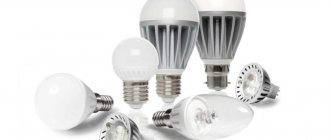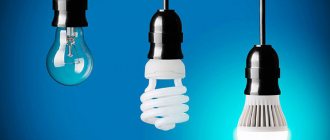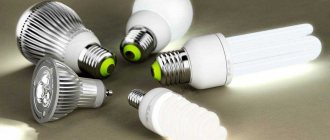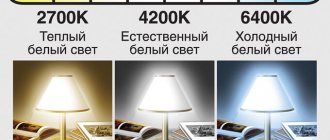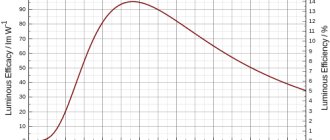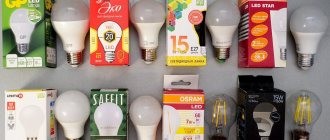When choosing a fluorescent (usually called energy-saving) or LED lamp, many buyers are guided by the inscription on the packaging indicating the power of an incandescent light bulb it can replace. But this approach is erroneous, since manufacturing companies often overestimate the technical indicators of their products.
So what is the right thing to do and what to pay attention to when choosing an LED lamp instead of a burnt-out fluorescent or incandescent lamp?
Table of correspondence between power and luminous flux
Unlike light bulbs with a spiral, the main selection criterion for which is power (W), you need to buy LED lamps based on luminous flux (lm). It is this physical quantity that indicates how much light power a particular light source emits. By the way, the packaging of all currently produced incandescent lamps also indicates the value of the luminous flux. The buyer just needs to learn how to correctly compare watts and lumens. And to make this task easier, below is a table of power and luminous flux for the three main types of lamps.
| Incandescent lamp | CFL | LED lamp | Light flow |
| 20 W | 5–7 W | 2–3 W | ~200 lm |
| 40 W | 10–13 W | 4–5 W | ~400 lm |
| 60 W | 15–16 W | 8–10 W | ~700 lm |
| 75 W | 18–20 W | 10–12 W | ~900 lm |
| 100 W | 20–25 W | 12–15 W | ~1200 lm |
| 150 W | 40–50 W | 18–20 W | ~1800 lm |
| 200 W | 60–80 W | 25–30 W | ~2500 lm |
From the comparison table it follows that a 100 W incandescent light bulb should be replaced with a 12-15 W LED light bulb. Why? Because their luminous fluxes are approximately equal and amount to 1200–1400 lm. At the same time, on the front side of the packaging of many LED lamps you can see 10 W = 100 W. But if you look at the table with the technical parameters of the LED light bulb, you can immediately see the discrepancy in the luminous flux.
In addition, the buyer must take into account 2 more important nuances:
- the light output of warm LED lamps (2700°K) is approximately 20% lower than that of similar neutral lamps (4000°K);
- the plastic diffuser bulb “eats” up to 10% of the emitted light. The exception is filament LED lamps with a transparent glass bulb, which have no scattering losses.
If you wish, you can independently calculate the approximate luminous flux of an LED lamp. To do this, you should use an empirical relationship: for every 1 watt of power consumed, the lamp emits about 100 lm. It is also necessary to subtract the energy losses on the driver (approximately 1 watt) and on the diffuser (approximately 100 lumens). As a result, it turns out that a 10 W light bulb creates a luminous flux of about 800 lm.
It is worth noting that the efficiency of LEDs is growing every year. Therefore, new models of LED lamps will have greater luminous power.
Benefits from using LED lamps. Calculation
The review would be incomplete without a practical comparison of the two lamps over the long term. Take, for example, a 40 W incandescent light bulb. Let's further assume that a person uses it on average 6 hours a day, that is, in total over 365 days this will be about 87,600 Wh per year.
An equivalent LED lamp, depending on the manufacturer, consumes 4.5 W or 9855 W/hour per year. To sum it up simply, the conclusion suggests itself: an incandescent lamp consumes 8.88 times more energy.
How to choose an LED lamp?
More details!
Disadvantages of LED lamps
There are, of course, disadvantages to LED lighting that are worth mentioning. First of all, this is its price. At the moment, their cost is higher among analogues. But the low power requirement of LED lamps described above and the longer operating life more than compensate for the high prices.
The heating level of LED sources is much lower than that of incandescent lamps, but is still present and can have a negative impact on the lighting system. For this purpose, special heat-removing radiators are installed in the models, but the installation of models with high power requires additional cooling measures.
Why such difference?
To answer this question, let's briefly look at the operating principle of each type of light bulb and compare their energy consumption. In an incandescent light bulb, the working element is a tungsten filament, which must be heated to 2000-3400°C to make it glow brightly. At the same time, approximately 95% of the lamp’s power consumption is spent maintaining the temperature of the coil, which means its efficiency will be only about 5%.
The operating principle of a compact fluorescent lamp (CFL) is to produce UV radiation by passing current through mercury vapor and then converting it into visible light using a phosphor layer. The energy efficiency of modern CFLs is approximately 5 times higher than their filament counterpart.
In LED light bulbs, light is produced by passing current through a pn junction and then passing it through a phosphor. The ratio of light energy to total power of the latest generation LED lamps can reach 30%. But there is no exact efficiency value for all LED bulbs, since it greatly depends on the type of LEDs and driver used.
Translation
Converting watts to kilowatts is done in the same way as other units of measurement, by multiplying by 1 thousand, which means the prefix “kilo”. That's why:
1 kW = 1000 W
Electrical power is measured in watts (W) - electricity consumption over a certain period of time. 1 W determines the number of joules consumed in 1 second.
Example of translation of other meanings:
Summing up
The power of the LED lamp, when choosing, is not a paramount value. Much more important is the luminous flux it emits. The same point applies to energy-saving CFLs. If we take a more pedantic approach to replacing burnt-out artificial light sources with LED analogues, then in addition to comparing light fluxes, it is necessary to take into account the pulsation coefficient, color rendering index and a number of other points, described in detail in the article on choosing LED lamps. It is also recommended to pay attention to the design features of the lamp in which the light bulb will be used.
Types of power
Some users have never thought about the fact that vacuum cleaners have two types of power, and the consumed parameter turns out to be not the main thing in the characteristics of modern household appliances designed to remove dust from rooms.
Attention! Manufacturers constantly use a cunning marketing ploy: on the packaging box and the product body itself, they indicate only the power consumption, because it looks respectable. A similar suction parameter is mentioned in the technical documentation that comes with each unit.
Power consumption
This parameter varies between 1500-3000 W, and many users believe that a powerful vacuum cleaner should have the highest similar performance, but this is not the case. This parameter indicates how much load this model puts on the home electrical network during operation, but there is no direct relationship between power consumption and the efficiency of the product.
Experts explain this by saying that the quality of operation of a home unit is influenced by many other factors, so two vacuum cleaners with equal power consumption will not produce identical and effective cleaning work. This parameter is always several times higher than the same suction characteristic, which is why all manufacturers indicate it in advertising their products.
During operation, it turns out that the lower the power consumption, the more economical the product and the less consumers will have to pay for the consumption of electrical energy. Therefore, for those who are going to frequently use a household unit to clean large rooms, it is better to purchase a small vacuum cleaner with average power consumption. If you plan to use such equipment no more than once a week to clean an average city apartment, then more power will not harm you.
Suction power
Its indicator is within the following limits: 250-480 W, a simple principle applies here: the more intensely the air is sucked in, the better the dust is removed. Based on suction power, modern household appliances can be divided into two types:
- for small rooms, a power of 250-320 W will be sufficient;
- with heavy dust and a large area - 350-500 W.
It should be taken into account that with constant operation at maximum power, the maximum service life of the product quickly decreases.
For allergy sufferers, for whom the quality of cleaning is very important, experts recommend a super-powerful vacuum cleaner with a cyclone filter and a HEPO 13 fine filter element, which traps all types of allergens. But you must be prepared for the fact that such equipment quickly wears out carpets, because it works at maximum speed without loss of suction power.
The concept of “useful power” includes two indicators:
- Maximum - it is achieved in the first seconds of product operation after switching on, while the dust container is still completely empty.
- Average efficiency, which characterizes the operation of the vacuum cleaner during the entire cleaning, since the degree of suction decreases due to the fullness of the dust bag or cyclone filter.
Operational tests showed that the second option is 30% smaller than the first.
Vacuum cleaners for allergy sufferers, what you need to know
Powerful models
Bosch BGL35MOV40
pros
- build quality
- five levels of filtration
- high suction power
- excellent equipment
- German reliability
Minuses
- not found
From 6094 ₽
Additional information: HEPA 13 fine filter, power regulator located on the housing, telescopic suction pipe made of stainless steel, vertical parking.
VITEK VT-1892
pros
- lightweight, maneuverable
- excellent suction power
- convenient to use and maintain
Minuses
- fragile plastic of all parts
- short hose (came off after third use)
- It makes a loud noise, like a plane taking off.
From 3800 ₽
Philips FC9174 Performer
pros
- very high suction power
- convenient and comfortable use
- It's not very noisy, especially at medium power.
- excellent equipment
Minuses
- not found
From 10390 ₽
VITEK VT-1898
pros
- good suction power
- large dust bag
- works amazingly quietly
Minuses
- very short network cable
- inconvenient and short hose.
From 5169 ₽
HOTPOINT/ARISTON SL CB24 AA0
pros
- great power
- removes all types of contaminants in the first pass
- multifunctional and convenient
Minuses
- not found
From 10990 ₽
What does it affect and what does it depend on?
A modern vacuum cleaner is a compact, but not small and at the same time quite complex unit, and its useful power is influenced by numerous factors:
- The engine is the most important among all components; experts call it the heart of the product. Its efficiency is 25-35% of the power consumption, i.e., with the specified parameter of 2 kW, the real suction power will be 500-700 W, respectively - this power is enough to clean any apartment, but there are other nuances that affect this parameter.
- Product types. A water filter, a plastic reservoir or a dust bag affects suction power differently due to its design and filling level.
- Type of filter elements and their quantity. The more complex the filter design, the more it reduces suction power. HEPA devices, due to their fine mesh design, have a fairly strong effect on suction power, especially after long-term use. For example, a vacuum cleaner with two coarse-mesh filters will show better suction results than an analogue with five fine-pored filters, but it will only retain large impurities.
- The build quality of the unit. With the same engine power, a vacuum cleaner that has a good and high-quality assembly with precisely fitted parts will show higher suction power. Therefore, the European assembly is valued by consumers much higher than the Asian or yellow one.
During cleaning, each user selects the optimal power mode of the unit using a special regulator located in the upper part of the product. Experts advise choosing devices with a power that is ideal for your apartment, so as not to overpay for extra kilowatts.
There are two main types of suction power regulators that are used on modern models of vacuum cleaners:
- Mechanical ones, which use a rotary switch to regulate this parameter from minimum to maximum value.
- Digital - adjustment is carried out by the control panel.
The second type is installed on elite class models, which have the highest cost.
As already mentioned, manufacturers do not indicate suction power, limiting themselves only to the same parameter consumed, so when choosing a model, simply divide the indicated power by four: for example, the product says 2.5 kW, which means the suction power will be at least 625 W, and this is quite high rate. Another way to find out this parameter is to look for it in the instruction manual, but even there, not all manufacturers indicate the exact characteristics.
All that remains is to find the required value on the Internet, to do this, insert the exact name of the model you are interested in into a search engine and look for all the information about it on the manufacturer’s website. Why do we pay so much attention to this particular technical characteristic? Because not only the quality of cleaning your premises depends on it, but also how easy this process will be.
What should be the suction power?
We have already figured out what factors this value depends on, now let’s see how to use it correctly in everyday life:
- 350 W - this power is quite enough for dry cleaning of surfaces such as linoleum, parquet, and floor tiles. If you do not have carpeting in the form of paths and large carpets with dense pile, and you are not going to clean upholstered furniture, then choose a product with this indicator.
- 400 W - you can clean carpet and upholstered furniture from pet hair.
- 450 W and more will successfully cope with long-pile carpets and upholstered furniture of any density.
It is better to choose equipment with a power regulator in order to clean any surfaces with reduced electrical energy consumption.
Note! Battery-powered vacuum cleaners, which are rapidly becoming fashionable, have low suction power. They can only be used for daily quick cleaning - in the form of an electric broom.
Vertical washing devices are armed with 400 W of suction power, because they remove not only dirt, but also moisture from surfaces.
